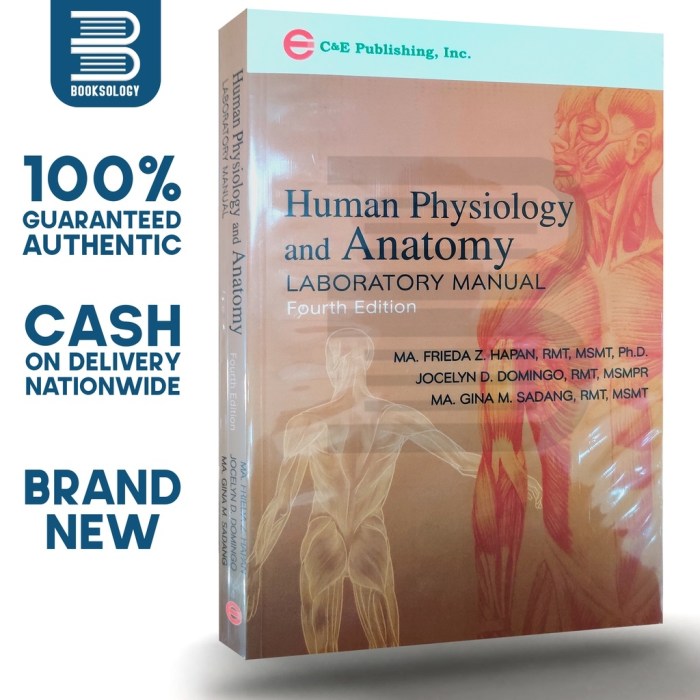Human Anatomy & Physiology Laboratory Manual 12th Edition is an indispensable resource for students pursuing a deeper understanding of the human body’s structure and function. This extensively revised manual provides a comprehensive overview of laboratory experiments, data analysis techniques, and safety protocols, ensuring an immersive and transformative learning experience.
With its meticulously organized structure, user-friendly design, and engaging pedagogical features, this manual empowers students to actively participate in the learning process, fostering a profound comprehension of human anatomy and physiology.
Overview of Human Anatomy and Physiology Laboratory Manual 12th Edition

The Human Anatomy and Physiology Laboratory Manual, 12th Edition provides a comprehensive guide for students in anatomy and physiology courses. It is designed to complement classroom instruction and enhance students’ understanding of the human body and its functions. The manual is intended for students with varying levels of background in anatomy and physiology, making it suitable for introductory courses as well as more advanced studies.
Key Features and Updates
- Updated content to reflect the latest advancements in anatomy and physiology.
- New experiments and activities to enhance student engagement and learning.
- Improved visuals, including high-quality photographs and illustrations, to clarify complex concepts.
- Expanded online resources, such as interactive simulations and quizzes, to support student learning outside of the laboratory.
Organization and Structure of the Manual
The manual is organized into 31 chapters, each covering a specific topic in anatomy and physiology. The chapters are arranged in a logical sequence, building upon each other to provide a comprehensive understanding of the human body.
Logical Flow of Chapters
The manual begins with an introduction to anatomy and physiology, followed by chapters on the skeletal, muscular, nervous, and endocrine systems. Subsequent chapters cover the cardiovascular, respiratory, digestive, urinary, and reproductive systems. The manual concludes with chapters on the senses, metabolism, and homeostasis.
Visual Aids
The manual is richly illustrated with high-quality photographs, diagrams, and charts. These visual aids enhance understanding of complex anatomical structures and physiological processes.
Laboratory Experiments and Procedures
The manual includes a wide range of laboratory experiments designed to reinforce students’ understanding of anatomical structures and physiological functions. Each experiment is accompanied by clear instructions, materials lists, and data analysis guidelines.
Purpose and Objectives
The experiments are designed to help students achieve specific learning objectives, such as:
- Identifying and describing anatomical structures.
- Measuring and analyzing physiological parameters.
- Testing hypotheses and drawing conclusions based on experimental data.
Data Analysis and Interpretation
The manual emphasizes the importance of data analysis and interpretation in the laboratory setting. Students are guided through the process of collecting, analyzing, and interpreting experimental data.
Statistical Methods
The manual introduces basic statistical methods, such as mean, standard deviation, and t-tests, to help students analyze their data.
Interpreting Results
Students are encouraged to draw meaningful conclusions from their experimental results and to relate their findings to the broader concepts of anatomy and physiology.
Health and Safety in the Laboratory
The manual places a strong emphasis on health and safety in the laboratory environment. It provides detailed guidelines for the proper handling of chemicals, equipment, and biological specimens.
Safety Protocols
Students are instructed on the following safety protocols:
- Wearing appropriate personal protective equipment (PPE).
- Following established laboratory procedures.
- Reporting any accidents or incidents immediately.
Applications of Anatomy and Physiology
The manual highlights the practical applications of the knowledge gained from the laboratory experiments. Students are shown how anatomy and physiology concepts are used in various fields, such as medicine, nursing, and exercise science.
Maintaining Health and Preventing Disease
The manual emphasizes the importance of understanding the human body in maintaining health and preventing disease. Students learn how to apply anatomical and physiological principles to promote healthy lifestyles and prevent common health problems.
Pedagogical Features and Learning Objectives
The manual incorporates a variety of pedagogical features to enhance student learning. These features include:
- Case studies to provide real-world examples of anatomical and physiological concepts.
- Review questions to help students assess their understanding of each chapter.
- Online resources, such as interactive simulations and quizzes, to support student learning outside of the laboratory.
Learning Objectives, Human anatomy & physiology laboratory manual 12th edition
Each experiment is associated with specific learning objectives. These objectives are aligned with the overall goals of the course and provide students with a clear understanding of what they are expected to learn.
Detailed FAQs: Human Anatomy & Physiology Laboratory Manual 12th Edition
What are the key features of Human Anatomy & Physiology Laboratory Manual 12th Edition?
The 12th edition boasts a user-friendly design, updated laboratory experiments, enhanced pedagogical features, and a strong emphasis on safety protocols.
How does this manual facilitate student learning?
Through interactive case studies, review questions, and online resources, the manual promotes active engagement and fosters a deeper understanding of anatomical and physiological concepts.
What safety measures are emphasized in the manual?
The manual places paramount importance on safety, providing detailed guidelines for handling chemicals, equipment, and biological specimens in the laboratory setting.